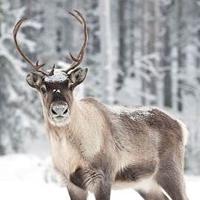Since the Jolly Ole Elf made his annual run this week, it would be a little wrong to write an article on deer hunting, especially since the gifts that the big guy delivers, come with the help of eight little hooved cervids.
So let’s take a different approach – here is a look at some of the interesting things about the Holidays and how wildlife fits in.
Reindeer (Rangifer tarandus), also called caribou (reindeer is the name for domestic version), are members of the Cervidae family, also known as the deer family. They are relatives of our native white-tailed deer, but the family also includes elk and moose. There is only one classified species of reindeer, but as many as 20 sub-species.
Reindeer are found in colder climates of the north, Canada, Alaska, Greenland, Russia and China, yes even the North Pole region. Scientist believe that reindeer may have been the first domesticated animals, as reports of arctic people raising them for food, clothing and material for shelter, go back thousands of years.
Growing up to 500 pounds, reindeer have long legs that help them move through snow, and large feet that make them more stable on slippery surfaces.
One unique feature that separates them from the other deer members is that both sexes grow antlers. Males use these for fighting and establishing dominance, females (and male) use them like snow plows, to uncover plant material covered by winter snow. In the winter the primary source of nourishment is a lichen called reindeer moss. Lichens are combinations of algae and moss that grows on rocks and other hard surfaces. The name caribou means “snow shoveler” in French.
The Safari Club International certifies trophy in six of the subspecies of caribou. Alaska-Yukon barren ground caribou are the subspecies with the largest antlers. The current world record was taken by Charles Pedrotte, with a rifle near the Salmon River in Alaska in October of 1980. This double shovel caribou had main beams that measured over 47” and 49” respectively, and he had an inside spread of 41 1/8”. He had an impressive 49 points and scored an astounding 588 7/8” overall.
In the wild reindeer travel in herds that range from 10 to 100 animals, but in the winter several of these herds come together in the winter feeding areas. Some of the largest groups may have up to 100,000 animals.
Because of the harsh conditions, reindeer have a rather short gestation period of seven months. Calves are able to stand soon after they are born, and can move with the herd in a matter of hours. Calves drink milk from their mothers, but start eating solid food in only a week. They are completely weaned within six months. Reindeer mature at four years and can live to the ripe old age of 15.
Caribou are members of a group of animals that have multiple chambered stomachs. Much like cows, they have four chambers to their stomach. This allows for grass and vegetation to be chewed, regurgitated, and re-chewed again before continuing the digestion process.
Rudolph was rumored to have a red nose, and maybe there is more truth to that than you might expect. Reindeer have lots of blood vessels that help to warm air before it passes to the lungs, so in cold weather, the nose appears to be red. Other parts of the body are covered in thick fur, including their hooves.
Speaking of fur, the fur of a reindeer is hollow and traps air inside. This provides much better heat retention and also provides buoyancy in water. Important since they cross large rivers and other bodies of water when migrating.
Reindeer also have specially adapted eyes to help them survive in the arctic habitat. They have the ability to see at a much lower wavelength, even ultraviolet, than humans, this helps them see objects that would generally blend in to an all-white landscape. The color of their eye changes from gold to blue though the seasons.
“Rudolph The Red-Nosed Reindeer” was “born” in the spring of 1939, at a time when the world was on the verge of a colossal war. He was the creation of Robert L. May, an advertising copywriter for the Montgomery Ward department stores, and the brother-in-law of composer Johnny Marks. Supposedly during a quiet lunch hour, May dreamed up Rudolph for a Christmas pamphlet as a promotional gimmick for Wards.
Marks approached Perry Como to record the song, but Como wanted changes to the lyrics and Marks refused. Gene Autry was next, but he originally said the song was too childish, good thing his wife stepped in and pushed her husband to record what became his biggest hit.
Merry Christmas!
Want to reach a local audience and grow your business?
Our website is the perfect platform to connect with engaged readers in your local area.
Whether you're looking for banner ads, sponsored content, or custom promotions, we can tailor a package to meet your needs.
Contact us today to learn more about advertising opportunities!
CONTACT US NOW






